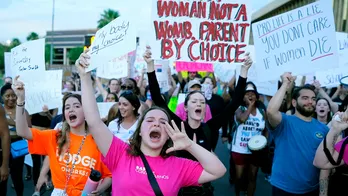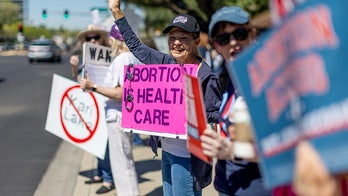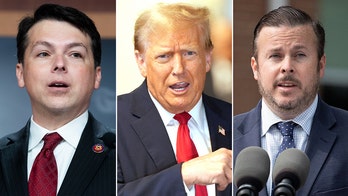
July 21, 2011: Donna Ciora, an employment specialist with Express Employment Professionals, right, talks with people attending the Pittsburgh Career Fair, in Pittsburgh. (AP)
WASHINGTON – The economy expanded at meager 1.3 percent annual rate in the spring after scarcely growing at all in the first three months of the year, the Commerce Department said Friday.
The combined growth for the first six months of the year was the weakest since the recession ended two years ago. The government revised the January-March figures to show just 0.4 percent growth -- down sharply from its previous estimate of 1.9 percent.
High gas prices and scant income gains have forced Americans to pull back sharply on spending in the spring. Consumer spending only increased 0.1 percent this spring, the smallest gain in two years. Government spending fell for the third straight quarter.
Stocks dropped in morning trading. The Dow Jones industrial average fell 100 points, and broader indexes also declined.
"These numbers are extremely bad," said Nigel Gault, an economist at IHS Global Insight. "The momentum in the economy is clearly very weak."
The sharp slowdown means the economy will likely grow this year at a weaker pace than last year. Economists don't expect growth to pick up enough in the second half of the year to lower the unemployment rate, which rose to 9.2 percent last month.
The weaker data will also add pressure to already-tense negotiations between President Barack Obama and lawmakers over increasing the debt limit. Any deal will likely include deep cuts in government spending. That could slow growth further in the short term.
But if Congress fails to raise the debt limit and the government defaults, financial markets could fall and interest rates could rise.
"It is hard to see the economy getting much stronger," Paul Dales, an economist at Capital Economics, said in a research note. "In fact, if the debt ceiling is not raised ... we could well have another recession on our hands."
Earlier this year, economists thought that a Social Security payroll tax cut would accelerate growth in 2011. But most of that money has gone to pay for higher gas prices.
Consumer spending on long-lasting manufactured goods, such as cars and appliances, fell 4.4 percent. Many auto dealers reported shortages of popular models after Japan's March 11 earthquake, cutting into auto sales.
Employers have pulled back on hiring after seeing less spending by consumers. The economy added just 18,000 net jobs in June, the fewest in nine months and a steep drop from the average of 215,000 jobs per month added from February through April.
Those who have jobs are seeing little gain in their incomes. After-tax incomes, adjusted for inflation, rose only 0.7 percent, matching the previous quarter and the weakest since the recession ended.
The drop in government spending was driven by cuts at the state and local level. Those governments have slashed spending in seven of the eight quarters since the official end of the recession.
Business investment, which has been a driver of growth during the recovery, also faltered this spring. Spending on equipment and software grew 5.7 percent in the second quarter, down from the first quarter's 8.7 percent pace and below the double-digit gains posted last year.
The government also revised data going back to 2003. The data show the recession was even worse than previously thought. The economy shrank 5.1 percent during the recession, which lasted from December 2007 through June 2009, compared to the earlier estimate of 4.1 percent. Both figures represent the worst downturn since World War II.
"The depth of the recession is now clearly so much deeper," Gault said.
Friday's report is the first of three estimates the government releases of the gross domestic product, which measures everything from restaurant meals to auto production to government spending.




